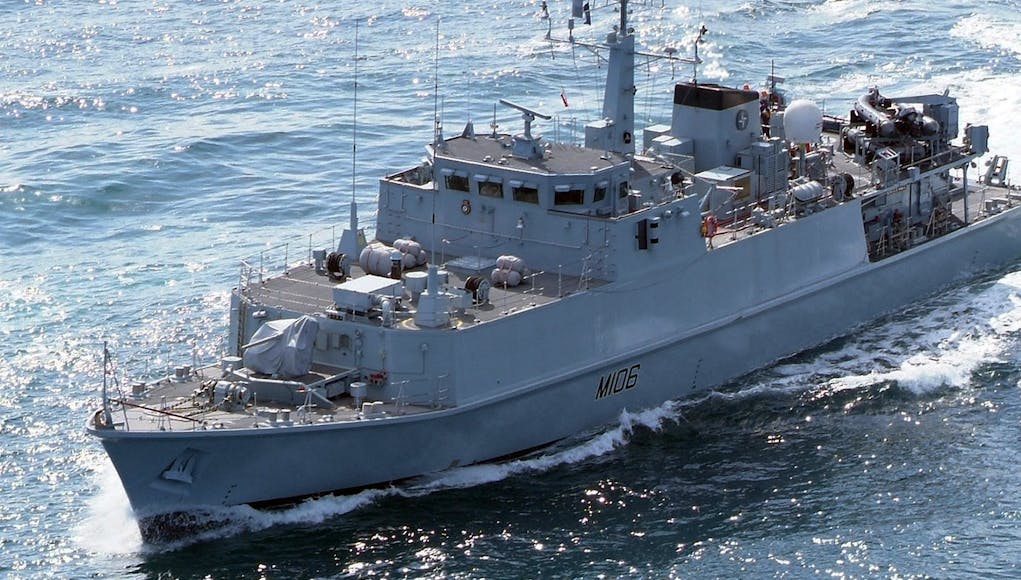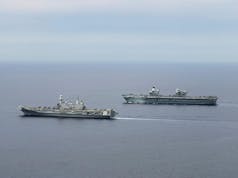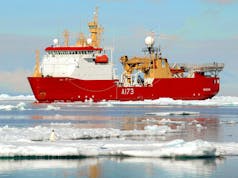The crews of minehunters HMS Penzance and Chiddingfold have sailed for the Middle East.
The Royal Navy say in a news release that this is the second time the two vessels have sailed in company to the Middle East for a three-year tour of duty, having last made the extended trip between 2014 and 2017.
“Heading back to the U.K., mission accomplished, once Penzance and Chiddingfold arrive, are their sister ships HMS Blyth and Ledbury. The Royal Navy has maintained a four-strong minehunting force – bolstered by a dedicated battle staff and mother ship, currently RFA Cardigan Bay – for more than a decade.
Together, they keep the sea lanes open, deter aggression, work with allies and fly the flag for the UK in a part of the world which is key to the nation’s security and economy. The two Gulf-bound ships are the first to switch over to a new crew rotational system – four months aboard instead of six, followed by four months back in the U.K. on leave/undergoing training, courses, education and the like. The program is intended to give sailors – 51 on Chid, 40 on Penzance – a more settled life, while getting the maximum out of their vessels on operations in theatre.”














Interesting to speculate on what this operation might look like in the future with a mission module based approach to MCM. As it stands it uses almost a third of the current MCMV fleet and a third of the Bays. Op Kipion as a whole adds T23 and T45 currently.
Perhaps Kipion might in future just comprise 2x T31 and 1x Bay (or similar) with the MCM role primarily operating from the Bay and shore based operations using USV and UUV, but with the option to scale up by including 1x or 2x T31 for MCM (and perhaps USV/UUV for littoral ASW). Or alternatively dedicating the 1x or 2x T31 to escort duty when heightened tensions require it as of now, and reverting MCM to just the Bay and shore based operations.
My main fear with container based systems, is that they consider that the whole capability could be packaged onto the 13 strong T31/T26 force, so no need for dedicated MCM assets.
I’m not against that idea, providing there’s an uplift in T31 numbers.
Certainly makes sense to put MCM assets onto a ship that can also protect itself in a potentially hostile area of operations.
I could see having T26 MCM capability with a CSG or amphibious group being desirable insurance, but I would be surprised if they ever had one focused on MCM otherwise. I can see the first 5x batch of T31 supporting MCM but not on their own.
We clearly can’t expect a one for one T31 per Hunt/Sandown replacement, but an additional 5x T31 plan would greatly increase flexibility of roles for the RN and we might hope for more. Even civilian class vessels in permissive areas could provide additional MCM. For example I can’t see the need for an RN or RFA spec vessel for Clyde operations or really any home waters use.
I also see an opportunity here to leverage reserve manpower. The RN might have a pool of MCM mission modules some of which can be used to train reserves using chartered civilian vessels that might be STUFT in time of raised tensions, predominantly used for home waters.
Seems like a good way to scale up and scale down capability without being locked into fixed function platforms or even just full time manpower.
Some great ideas there…..
But wait there’s more 🙂
Consider using the same approach using UAV, USV, UUV for littoral/home waters ASW. UAVs to drop sonarbuoys, USV for towed sonar and UUV for remote patrolling. The T26s are the high end blue water ASW, the T31s are the lower end. The same scale up and scale down capability using navy reserves also applies here to, although using commercial spec vessels as a mothership for an ASW may be a bit too risky. Using River-class might be acceptable though.
An additional requirement is the ability to prosecute an attack which would need Wildcat launched torpedoes for platforms that don’t have one, with a gold plated option to add dipping sonar to the Wildcat. This would require more Wildcats for the RN. They might be transferred from the AAC much like the Merlins were from the RAF. The AAC then replace them with the US Future Attack Reconnaissance Aircraft (FARA) provided it delivers significant increased capabilities over the Wildcat at low cost as planned.
Makes great sense to me. I would absolutely reallocate Army Wildcats to the Navy, fully fitted out with sonar etc.
The AAR could simply buy more AH64E’s for scouting and perhaps Lakotas for transport duties.
Both procured from US production at low cost.
Using unmanned systems (Air, surface and subsurface) has to be the way to go, perhaps with a range of new RFA support ships based on a large common hull form, with the flexibility of being re-rolled as a Mine countermeasures mothership as required.
The US tried Apaches for scouting, replacing the Kiowas but now want to move to the FARA, IIRC it was something to do with operating costs of the Apaches and higher maintenance but don’t quote me. Of course the current Wildcats are expensive too.
With the FARA program now down to either the Bell 360 Invictus or Sikorsky Raider X candidates, the UK might piggyback onto the program for a more focused light armed scout solution, assuming it doesn’t get cancelled, the aircraft are in fact affordable and do offer improved capabilities over Wildcat. For utility roles, the Lakota, or other EC135/145 military derivatives are affordable with the latter already used in UK civilian roles.
Lets hope we get new mine warfare ships as we need the numbers to achieve all the current duties and future ones anything less will be bad news for the Royal Navy. We need 12 replacements.
The problem with replacing existing MCMV with similar vessels is lack of flexibility for the RN. We would then again have vessels that are dedicated to MCM with a backup OPV role. We don’t need anymore OPVs, we need more capable vessels. We also then tie manpower to the MCM mission only without flexibility for other roles. The mission module approach to MCM operations enables far greater flexibility regarding vessels used, or not even requiring a vessel for shore based operations as previously outlined.
In an ideal world Cam, yes, but……we live in a way too liberal Country where successive governments have been too scared to upset the lefty liberal public and have therefore been robbing the armed forces of our Country of the correct level of funding that is required in these dangerous times.
The Navy has suffered a lot over the years and even though we have two fancy supercarriers, the escort force of destroyers and frigates is too small in my opinion. There should’ve been 8 or 9 Type 45’s and we should be getting 13 Type 26’s to replace the 13 ageing 23’s but…….what are we getting? Only 8 Type 26’s and 5, maybe 6 smaller and less capable Type 31 diet frigates.
The other thing that gets me is the fact that I think the government should pay for our nuclear deterrent……NOT the M.O.D, just think how much that costs to get, eh?
If we can get a second batch of properly armed T31, this is where the first batch could be useful. A largish frigate with sufficient armament for low risk patrol, but plenty of space for a secondary MCM role. Load them up with off board systems and fit them with a hull sonar if they dont get in their initial fit out. Could the provision of wildcat helicopter also aid mcm with the right equipment?
I would also like to see us start exploring a mothership concept soon. Addition of larger scale autonomous systems to our current vessels will just be a fudge, and a vessel designed from the off to provide the full range of fixed wing, rotary, surface and sub drones could be very useful in a number of scenarios. I’m thinking a 15k tonne hull with flight deck, launchers, retrievers and hanger for aerial, a well deck for surface and smaller underwater stuff, and side cranes and sponsons for the proposed extra large UUV.
These could be attached to a CSG to assist in ASW work and add to the reach of the radar early warning picture. They could protect shipping convoys from pirates or gun boats using the armed surface boats, or be used to close off large areas of ocean to enemy submarines using a handful of the extra large UUV’s and rotary drones with a dipping sonar.
I believe the mothership concept is the way forward and would add a truly versatile capability for a modest spend.
The USN’s Independence Class LCS have been designated as the dedicated platform for the new unmanned MCM systems. The class will actually do pretty well at this IMO. They have a large well deck, hanger, and flight deck ideal for the mission. Hopefully the USN will finally find a good use for these hulls – we certainly need the MCM assets.
https://www.navy.mil/submit/display.asp?story_id=108404
Cheers
It’s a shame that the LCS program has had so many faults and nay sayers. Perhaps it was a stretch too far, asking a largish warship to sustain a speed of 40+ knots. But I applaud the two companies on their designs. You would have thought that with the flexible mission bays, stern ramp and side door would be extremely advantageous, but it looks like the USN just aren’t sold on the idea, more ABs please. The Independence design with its massive flight deck and equally large mission bay was at one point earmarked as a troop ship.
But finally it looks like the USN have finally agreed on what he ships might be used for, i.e. MCM. It does make a lot of sense. They have enough self-defences to take care of themselves. But also the space to deploy multiple methods of searching for and dealing with mines.
For us, we will probably get an adaptation of a Batch 2 River, that does both of the MCM roles, which means as usual, they can do more with less! However, this is probably a stretch, the trimaran hull shape used by the Independence class lends itself as a very flexible multi-role platform, especially in the role as a mother ship to unmanned vehicles. Perhaps not the size of the LCS but more in keeping with the B2s, so it doesn’t tread on the T31s toes. Equipped with a stern ramp, large side doors and possibly a well deck, would enable simultaneous methods of dropping off or retrieval of unmanned vehicles.